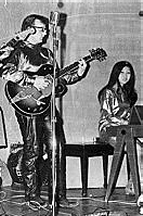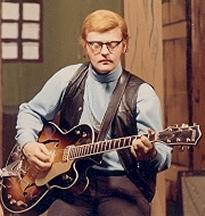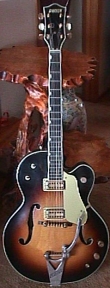
Hillman Guitar No. 4
GRETSCH COUNTRY CLUB
Model 6192
Serial Number: 78417
1965
www.hillmanweb.com/hillgt04.html
.
My Gretsch Country Club guitar was purchased a few months before Sue-On and I were married in the summer of '66. The Club, along with my first Fender Telecaster, was chosen to replace my first Gretsch, the Chet Atkins Nashville model after it had been stolen. At this time, I was very much into using a De Armond volume pedal for sustain to simulate steel guitar sounds. This was a technique I had picked up after watching Ferlin Husky's lead player use it at a Brandon Arena show a few years earlier.Also, by this time I was using what I believe was the first ever distortion pedal: the Gibson/ Maestro Fuzz-Tone. It was originally pitched as a brass instrument emulator, but the reaction this wild driving sound got from audiences was nothing like that obtained by any brass instrument. In fact, it is hard to imagine now that there was a time when rock guitars didn't use distortion.
So, although I used both guitars at every gig, I found that the bite of the Tele was more appropriate for the style I was developing and I used the Gretsch less and less. Then, when my original Gretsch was recovered, the Country Club was left at home, to be brought out for the occasional special function, practise or television show.
It is really quite a gorgeous instrument and I always thought it would be an ideal jazz or big band instrument if the opportunity ever came along for me to play in such a band. My only regret with the instrument is that, to cut costs, I had ordered a chrome Bigsby rather than the brass model. All the other fittings on this sunburst guitar are brass, so the Bigsby isn't a good match. This showpiece seems to be a close cousin to the very much in demand, thick bodied 6120 and deserves to be played much more than it is . . . O well . . . someday . . . .

GRETSCH COUNTRY CLUB PHOTO ALBUM

1967 Dance Date
Telecaster in the wings
Country Club in Action
Sue-On on Hohner Pianet
1968 CKX-TV Show
Sue-On on stand-up drums. 

Taping our weekly show at CKX-TV studios
EVOLUTION OF THE COUNTRY CLUB MODEL

Gleaned from Web References:
The Gretsch Pages
Gretsch Homepage
Artists Who Play Gretsch Guitars
Gretsch History
Vintage Guitar Parts
1941 Patent: Gretsch Design for a Guitar
Bigsby Website
Vintage Guitar Magazine Online
Musician.com














